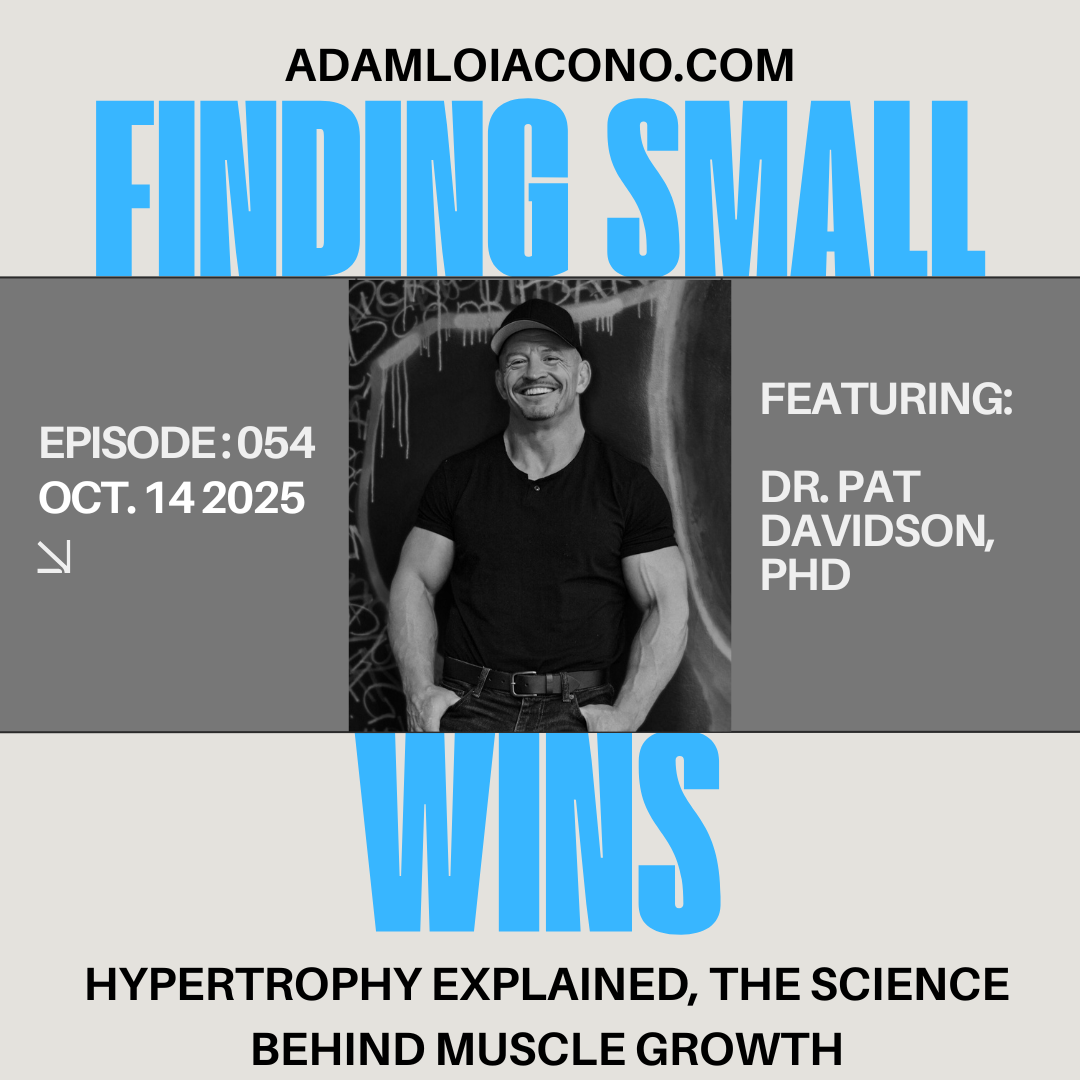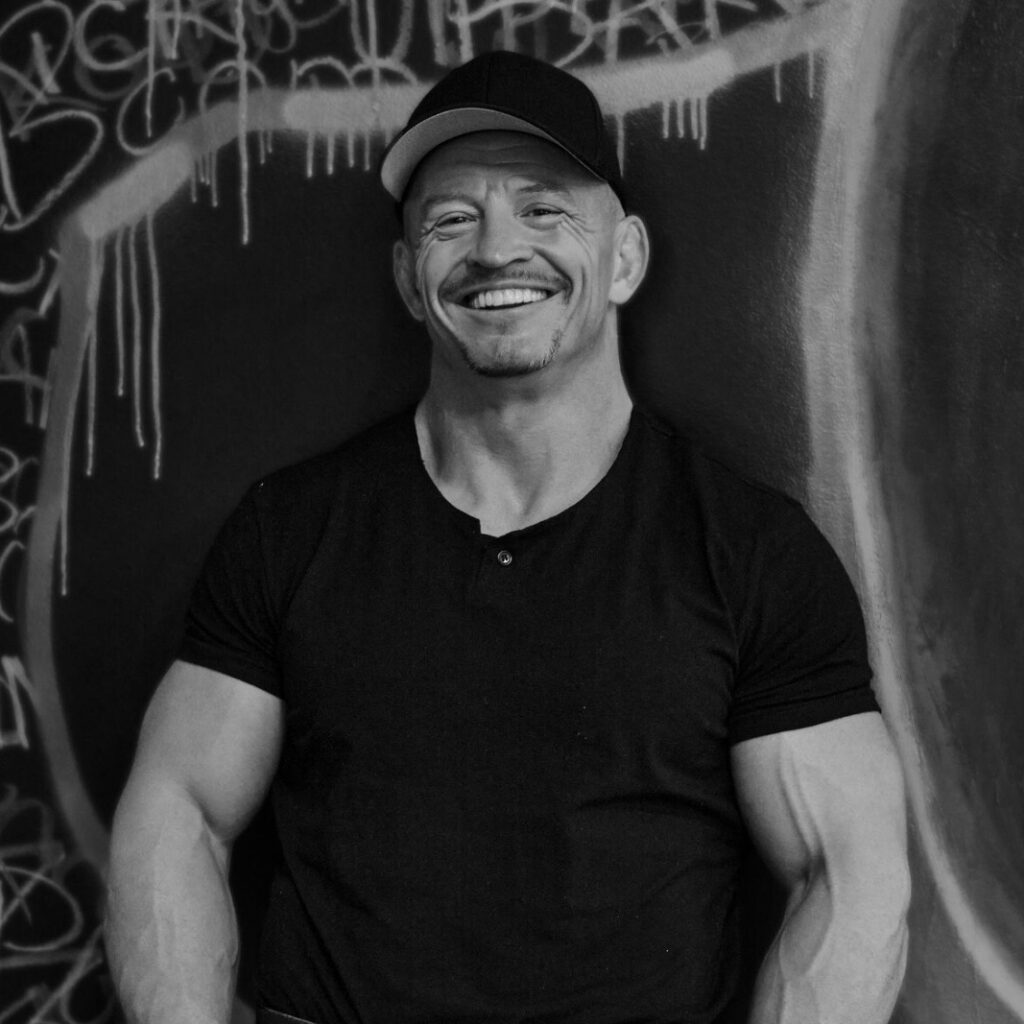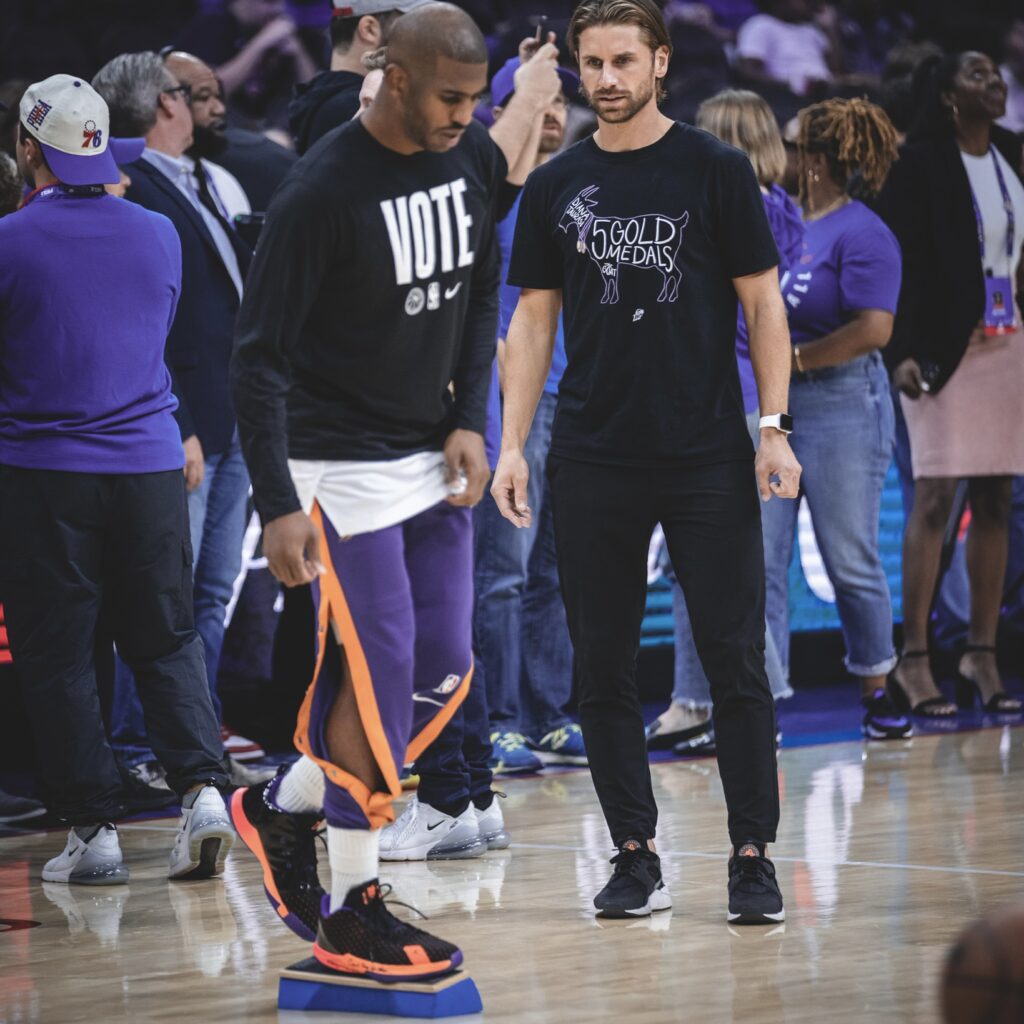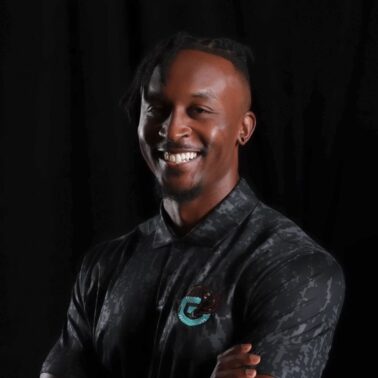“Muscles don’t respond to load—they respond to torque.” — Dr. Pat Davidson
What You Will Learn
- How mechanical tension and torque drive muscle hypertrophy.
- Why exercise setup and joint position change growth stimulus.
- How science-based hypertrophy applies to rehab, sport, and longevity.
Introduction
If muscle told its story, it would sound like history written in stress. Each rep records how we move, adapt, and recover. Hypertrophy—often reduced to “bigger muscles”—is really the physiology of adaptation. It’s how tissue learns to carry more load, tolerate more torque, and perform under greater tension.
In this episode of the Finding Small Wins podcast, I sit down with Dr. Pat Davidson, PhD, a rare combination of scientist, strength coach, and competitive bodybuilder. We peel back the layers of muscle science—what actually triggers growth, what myths persist, and how hypertrophy training can serve not just aesthetics, but athletic performance, injury prevention, and longevity.
Most conversations about muscle growth still orbit the same clichés: high reps, short rests, and a protein shake after training. Davidson breakdowns bro science with academic precision and gym pragmatism. He reminds us that hypertrophy is not a feeling or a pump—it’s a mechanical event, built on physics as much as physiology.
Guest Background: Pat Davidson, PhD
Dr. Pat Davidson earned his Ph.D. in Exercise Physiology, taught at Springfield College, and has spent two decades coaching athletes, fighters, and lifters. He’s competed in strongman, mixed martial arts, and professional bodybuilding—a résumé that bridges textbook theory with chalk-dust reality.
Beyond the platforms and podiums, Davidson is a systems thinker. He distills complex biomechanics into usable principles for coaches and clinicians. His MASS training programs and Resistance Patterns seminars have reshaped how strength professionals view exercise selection and progression.
When Davidson speaks about hypertrophy, it’s not a guess; it’s lived science. He’s tested torque with his own joints and validated tension through the weight he’s moved.
The Principles of Hypertrophy: Specificity Rules Everything
“The textbook never lies—specificity, overload, individuality, and reversibility still run the show.” — Davidson
Every training adaptation bows to four governing laws: specificity, overload, individuality, and reversibility. Hypertrophy is no different.
Specificity means a muscle only adapts to the forces placed upon it. To grow, it must experience direct, repeated tension through its functional range. A biceps won’t grow from leg extensions, just as an athlete won’t sprint faster from endless bench presses.
Overload is about threshold. Growth begins only when tension surpasses what the tissue can comfortably tolerate. For hypertrophy, the “load window” is wide—roughly from your 30-rep max up to your 5-rep max—but proximity to failure is what matters most. The closer a set comes to mechanical failure, the louder the muscle’s signal for adaptation.
Individuality recognizes that beginners can grow with almost any stimulus, while experienced lifters must push closer to failure or vary torque profiles to keep progressing.
And reversibility is the final reminder: what you don’t stress, you lose. Muscle is a rent-to-own system—stop paying tension, and it takes back its gains.
| Principle | Definition | Applied Example | Clinical / Coaching Insight |
|---|---|---|---|
| Specificity | Muscle grows in response to the exact stress placed upon it. | Biceps won’t grow from squats; train the muscle through its own joint action. | Match exercise to target muscle and movement pattern. |
| Overload | Growth requires tension that exceeds current tissue capacity. | Work near mechanical failure with 30–5 rep max loads. | Stimulus must challenge without exceeding recovery. |
| Individuality | Training response depends on experience, genetics, and tolerance. | Novice: grows with submax effort. Elite: needs higher intensity or novel torque profiles. | Customize volume and proximity to failure per athlete. |
| Reversibility | Without ongoing stress, muscle size and strength regress. | Miss a few weeks of training? Expect measurable atrophy. | Load consistency matters more than novelty. |
Mechanical Tension and Torque: The True Stimulus
“You can lift heavy without tension, but you can’t grow without torque.” — Davidson
The hypertrophy signal isn’t magic—it’s mechanical tension, the force that deforms muscle fibers. Torque, the rotational expression of that force, dictates how much tension the tissue actually experiences.
Torque is determined by two variables: load and distance from the joint’s center of rotation. Increase that horizontal distance, and torque multiplies—often exponentially. It’s why a lighter weight held farther from the joint can produce more stimulus than a heavy load held close.
Davidson contrasts two classic biceps exercises. In an incline dumbbell curl, the arm hangs behind the torso; as the dumbbell lowers, the weight moves closer to the elbow, reducing torque at length. In a preacher curl, the weight drifts farther from the joint as the elbow extends, increasing torque in the stretched position. The result? Greater mechanical tension and more growth—despite lighter loads.
Muscle doesn’t count plates; it measures strain. Every joint angle and equipment setup changes that equation. The goal is not maximal load—it’s maximal torque in the ranges where tissue can tolerate and adapt to it.
| Variable | Definition | Training Implication | Example Exercise Bias |
|---|---|---|---|
| Load | External resistance applied to a joint or muscle. | Heavy load ≠ high tension if torque is low. | Heavy partial squats = high load, low torque. |
| Torque | Rotational force = Load × horizontal distance from joint. | Increase torque by increasing lever arm (distance). | Preacher curl > incline curl for biceps tension. |
| Active Tension | Force created by muscle contraction. | Produced during concentric and isometric actions. | Pressing, curling, pulling. |
| Passive Tension | Force created by tissue stretch. | Occurs at end range; amplifies mechanical signal. | Deep squats, Nordics, flyes at stretch. |
| Optimal Growth Zone | High torque + long muscle length + near-failure effort. | Combine load and position for maximal stimulus. | Pendulum squat, seated hamstring curl, incline press. |
Isometrics, Eccentrics, and the Language of Stress
“Length matters. A stretched muscle under high torque is a stimulus factory.” — Davidson
Recent research has flipped traditional assumptions: isometric contractions—when performed in lengthened positionsunder high tension—can stimulate hypertrophy comparable to full dynamic sets. The common denominator? Tension at length.
Active tension (from muscle contraction) and passive tension (from tissue stretch) converge most powerfully when a muscle is loaded near its end range. That’s why exercises like Nordics for hamstrings or deep squats for quads produce disproportionate adaptations—they live in the high-torque, lengthened neighborhood.
For clinicians and rehab specialists, this principle reframes isometrics from “gentle activation” to “precise remodeling.” A long-length isometric can both desensitize pain and maintain tissue quality when dynamic loading isn’t yet safe.
In performance contexts, blending eccentric control with lengthened-position isometrics—think slow-lowering split squats or paused presses—builds not just size, but durability. The tendon learns to tolerate force; the muscle learns to own it.
Programming for Growth: Volume, Progression, and Practicality
“Eight to twenty-four working sets per muscle per week—that’s your sweet spot.” — Davidson
Volume is the currency of hypertrophy. Research and practice converge on a range: 8–24 sets per muscle group per week, escalating gradually across a mesocycle. The process is simple—start near eight, end near twenty-plus.
Early weeks prioritize technique and recovery. Later weeks trade comfort for accumulation. What matters is not chasing soreness but sustaining progression.
A practical template:
- Weeks 1-2: 8–10 sets per muscle per week
- Weeks 3-4: 12–16 sets
- Weeks 5-6: 18–24 sets, followed by a deload
Exercise selection matters as much as set count. Favor movements that challenge the target muscle in its lengthened position with stable support—pendulum squats, incline presses, seated hamstring curls, cable fly variations.
Recovery completes the loop. Growth occurs not in the gym but in the restoration of stressed tissue. Adequate sleep, protein (~1.6–2.2 g/kg), and low chronic fatigue are the invisible variables that separate adaptation from exhaustion.
| Training Phase | Volume Range (Sets/Muscle/Week) | Primary Focus | Example Exercise Selection | Notes |
|---|---|---|---|---|
| Foundation (Weeks 1–2) | 8–10 | Technique, recovery, tolerance | Supported machines, moderate loads | Establish baseline tension, minimize fatigue. |
| Accumulation (Weeks 3–4) | 12–16 | Volume expansion, progressive overload | Mix of machines + cables; lengthened tension work | Add sets before adding load. |
| Intensification (Weeks 5–6) | 18–24 | Peak stimulus, near failure | Free-weight or compound lifts with torque bias | Monitor joint stress; plan deload next. |
| Deload (Week 7) | 6–8 | Recovery, recalibration | Light, short-position movements | Absorb adaptation before next mesocycle. |
Machines, Cables, and Free Weights: The Physics of Support
“If you’re trying to move weight forward, you’d better have support behind you.” — Davidson
In hypertrophy training, support isn’t cheating—it’s physics. According to Newton’s third law, every action needs an equal and opposite reaction. Push forward, and you need something solid behind you. Pull backward, you need stability in front.
That’s why machines often outperform “functional” free-weight setups for pure muscle growth. They provide external support, allowing you to generate more internal tension without wasting energy on balance.
Davidson categorizes tools by stability:
- High support (on tracks): leg press, Smith machine, chest-supported rows — maximal force, minimal skill demand.
- Moderate support: free-weight squats, split squats — balance and tension share the workload.
- Low support: cables, dumbbells, unilateral work — more skill, less absolute load.
For athletes or rehab clients, support can be scaled. Early-stage or hypertrophy-focused phases benefit from higher support; later, when coordination and rate of force matter, transition to freer movement.
The hierarchy isn’t moral—it’s mechanical. Machines create certainty; free weights create chaos. Smart programs use both.
| Support Level | Tool / Example | Force Potential | Skill Demand | When to Use |
|---|---|---|---|---|
| High Support | Leg Press, Smith Machine, Chest-Supported Row | Maximal | Low | Early rehab, hypertrophy phases, load focus. |
| Moderate Support | Free-Weight Squat, Split Squat | High | Moderate | Strength phases; skill + load balance. |
| Low Support | Dumbbell Press, Cable Fly, Unilateral Work | Moderate | High | Late rehab, sport transfer, coordination emphasis. |
| Minimal Support (Dynamic) | Stability Ball, Free Space | Low | Very High | Movement prep, accessory integration, not hypertrophy focus. |
Conclusion: Muscle Literacy
Hypertrophy isn’t vanity—it’s literacy in how the body adapts. Understanding tension, torque, and position transforms exercise from repetition to conversation.
5 Actionable Wins
- Train near failure, not through pain. Effort, not exhaustion, drives adaptation.
- Favor long-length tension. Stretch plus torque equals growth.
- Use support strategically. Machines amplify force; free weights build skill.
- Progress volume gradually. Add sets before adding chaos.
- Treat muscle as medicine. More muscle equals more resilience—across sport, rehab, and lifespan.
Listen to the Full Episode Here

Episode Timeline
- 00:00 – Setting the Stage: Adam and Pat reconnect, tracing two decades of shared history from Massachusetts gyms to global platforms.
- 05:00 – From Academia to Iron: Pat’s transition from PhD classrooms to bodybuilding stages; what academia taught him about curiosity and limits.
- 10:00 – The Athlete’s Mindset: Competing, winning, and the psychology of chasing excellence across sports, pain, and identity.
- 15:00 – Defining Hypertrophy: The difference between “getting bigger” and true tissue adaptation; why context matters more than weight on the bar.
- 20:00 – The Four Pillars: Specificity, overload, individuality, and reversibility—how these classic principles still govern modern hypertrophy.
- 25:00 – The Mechanics of Growth: Torque vs load, tension as the real signal, and why joint position dictates stimulus.
- 30:00 – Exercise Profiles Explained: Comparing preacher curls, incline curls, and squats to reveal how resistance curves shape hypertrophy.
- 40:00 – The Lengthened Advantage: How loading muscles in stretched positions changes adaptation; why “length is leverage.”
- 50:00 – Isometrics & Eccentrics: Exploring the latest research showing lengthened isometrics can rival dynamic sets for growth.
- 1:00:00 – The Science of Torque: Breaking down moment arms, Newton’s laws, and why biomechanics—not bro-science—builds muscle.
- 1:10:00 – Machines vs Free Weights: Rethinking support, balance, and Newton’s third law to maximize hypertrophy and safety.
- 1:20:00 – Programming the Details: Weekly set targets, progression models, and how volume becomes the currency of growth.
- 1:30:00 – Rehab Meets Hypertrophy: Applying these same principles to ACL recovery, tendon rehab, and post-op muscle preservation.
- 1:40:00 – BFR, Peptides, and Physiology: The controversial middle ground—how metabolic stress, pharmacology, and recovery shape tissue change.
- 1:50:00 – Muscle and Longevity: Why muscle mass predicts lifespan; the concept of hypokinetic disease and protecting health through movement.
- 1:55:00 – Reflections and Small Wins: The human side of science—friendship, curiosity, and how competition fuels lifelong learning.





